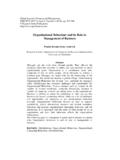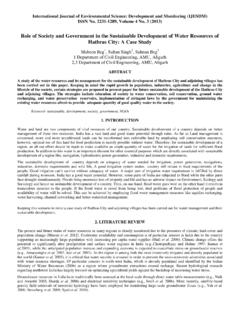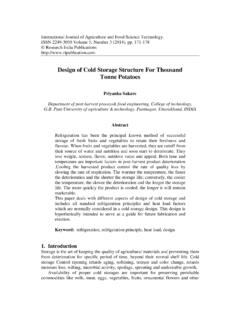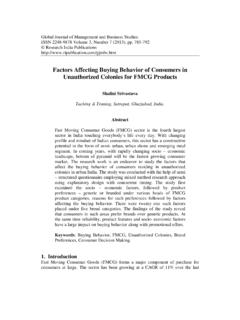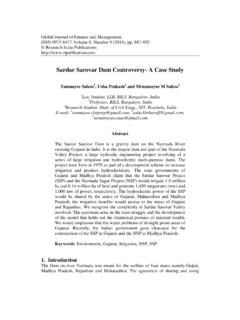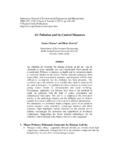Transcription of Role of Training & Development in an …
1 International Journal of Management and International Business Studies. ISSN 2277-3177 Volume 4, Number 2 (2014), pp. 213-220 Research India Publications Role of Training & Development in an Organizational Development Vinesh Research Scholar, (PG) College Meerut, CCS University, Meerut Abstract Training and Development is the field which is concerned with organizational activity aimed at bettering the performance of Individuals and groups in organizational setting. It is a combined role often called human resources Development (HRD) meaning the Development of Human resources to remain competitive in the marketplace. Training focuses on doing activities today to develop employees for their current jobs and Development is preparing employees for future roles and responsibilities.
2 It carry out an analysis that the objective of Training and Development is to creative learning organizations which ensure that employees through value addition can effectively perform their jobs, gains competitive advantage and seek self growth: this measurable performance resulting from good Training and Development , shall enhance organization Development . It is a process transferring information and knowledge to employers. It is equipping employers to translate that information and knowledge into practice with a view to enhancing organization effectiveness and productivity, and the quality of a management of people. It should be considered along with education policies and systems which are crucial to the Development of human resources. Keywords: Training and Development , goals, Role in achieving Organizational Performance.
3 1. Introduction Conventional Training is required to cover essential work-related skills, techniques and knowledge, and much of this taking a positive progressive approach to this sort of traditional Training . Training and Development guide is oriented chiefly around what s Vinesh 214good for people, rather than chiefly what s profitable for organizations. The reason for this is that in terms of Training , and Development , what s good for people is good for the organizations in which they work what s good for people s Development is good for organizational performance, quality, customer satisfaction, effective management and control, and therefore profits too. Organizations which approach Training and Development from this stand point inevitably foster people who perform well and progress, and importantly, stay around for long enough to become great at what they do, and to help others become so.
4 Training is a very commonly used word, it traditionally belongs to the trainer or the organization, it should be about whole person Development not just transferring skills, the traditional interpretation of Training at work. Being realistic, corporate attitudes and expectations about what Training , and does cannot be changed overnight, and most organizations skill see Training as being limited to work skills, classrooms and power point presentations-However, when your start to imagine and think and talk about progressive attitudes to developing people beyond and traditional skills Training . The objectivity of Training and Development and its continued learning process has always been leverage with an organization and now it has become rather an over arching trend of social needs, emphasizing that organizations must inculcate learning culture as a social responsibility.
5 It has been also proved by many studies in the past that there are sound connections between various Training and Development practices and different measures of organizational performance. 2. Literature Review Training and Development As defined by Richard Beckhard, Organization Development (OD) is a planned, top down, organization-wide effort to increase the organisation is effectiveness and health. OD is achieved through interventions in the organization s Processes using behavioural science knowledge (i) According to warren Bennies, OD is a Complex strategy intended to change the beliefs, attitudes, values, and structure of organizations so that they can better adapt to new technologies, markets, and challenges. Warner Burke emphasizes that OD is not just anything done to better an organization, It is a particular kind of change process designed to bring about a particular king of end result OD involves organzational reflection, system improvements, Planning and self analysis.
6 Training and Development and its Process In order to ensure that our employees are equipped with the right kind of skills, knowledge and abilities to perform their assigned tasks, Training and Development plays its crucial role towards the growth and success of our business. By choosing the right type of Training , we ensure that our employees possess the right skills for our business, and the same need to be continuously updated in the follow up of the best and new HR practices. To meet current and future business demands, Training and Development process has assumed its strategic role and in this regard few studies by Role of Training & Development in an Organizational Development 215 Stavrou et al. s (2004) and Apospori, Nikandrou, Brewster and Papalexandris s (2008), have attained much importance as these highlight the T&D practices in cross-national contexts.
7 Apospori et al. (2008) had deduced that there is a considerable impact of Training on organizational performance. Differently from these studies, Cunha, Morgado and Brewster (2003) were the only ones who could not determine the impact of Training on organizational performance, and suggested that another study on analysis of this relationship was needed. 3. Importance of Training and Development in an Organizational Development Training and career Development are very vital in any company or organization that aims at progressing. This includes decision making, thinking creatively and managing people. Training and Development is so important because- Help in addressing employee weaknesses Improvement in worker performance Consistency in duty performance Ensuring worker satisfaction Increased productivity Improved quality of service and products Reduced cost.
8 Reduction in supervision. 4. Objective of the Study T&D The Major objective of the study is to analyze the role of Training and Development in an organization Development . The following are the specific objective of the study. Training and Development helps in optimizing the utilization of human resources. Training and Development helps in increasing the productivity of the employees. Training and Development helps in creating a beeter corporate image. Training and Development helps in inculcating the sense of team work,team spirit, and inter-team collaborations. Training and Development helps in improving the health and safety of the organization thus preventing obsolescence. 5. Approaches to T&D Reactive Approach The traditional approaches to Training can be generally termed as reactionary, driven by tactical delivery of technical skills in bricks and mortar, classrooms trainings and where Training is seen as an event oriented activity.
9 Vinesh Proactive Approach In the learning organization this approach aligns all learning activities with the corporate business strategy, and its focus is on developing competencies. Active Learning Approach In this approach, trainees play a leading role in learning by exploring issues and situational problems under the guidance of their facilitator. The trainees learn by asking thought provoking questions, searching for answers, and interpreting various observations made during the process. The active learning approach has its lasting impact on learning since it helps in long-term retention and finding better solutions in the challenging situations. In today s fast paced world, continuous learning is essential to success. Individuals need to learn to succeed in life and at work. Companies need to ensure their employees continue to learn, so they can keep up with increased job demands and so the company can gain or maintain competitive advantage.
10 6. Discussion Training and Development (i) Identification of Training and Development Needs Managers are expected to discuss Training and Development needs with each of their staff at least annually as part of the Performance Review and Planning process. The Training and Development needs of staff newly appointed to their positions should be discussed within four weeks of their taking up the position, whether or not they are new to the organization. (ii) Internal Training and Development Sessions The Training and Development Unit organises Training for staff on all campuses sites and can set up specific sessions to meet identified needs for a department or section group of departments, or occupational group. Computing Services also administers an ongoing programme of courses for staff and other organization sections and departments offer Training sessions for staff as needs arise.
